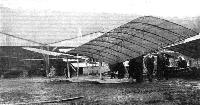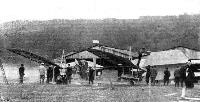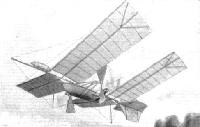Журнал Flight
Flight, July 5, 1913.
THE PIONEERS.
<...>
In America, the work of Langley is the most notable next to that of the Wrights. Professor Langley as secretary of the Smithsonian Institution at Washington, D.C., held one of the highest scientific posts in the country, and he devoted most of his spare time to the study of flight. His experiments on the lift and resistance of inclined flat plates when moved through the air on the end of a whirling arm, are classic, likewise his treatise on the internal work of the wind. His experiments on model flying machines were characterised by a most extraordinary patience and perseverance, much of which was of necessity devoted to the construction of the small steam engine with which they were equipped.
The type of aeroplane that Langley adopted may be described as a tandem monoplane, that is to say it had a similar pair of wings fore and aft. The later flights of his models were very successful, and Langley was commissioned by the American Government to build a full-sized machine. This machine he constructed on more or less the same lines as his models, and an attempt was made to fly it over the Potomac River. It was mounted on the roof of a houseboat, and had a special launching apparatus. This unfortunately failed to act properly, for it tipped the machine head first into the river. The aeroplane was repaired and another attempt was made, but the same thing happened again, and the authorities, being none too enthusiastic, withdrew their further support. Langley very naturally suffered a great disappointment in this, as well he might, for it is a poignant fact that nine days later the Wrights made their first successful flights. It was, in fact, on December 8th, 1903, that the second failure of the Langley aeroplane took place at Arsenal Point, near Washington, and on December 17th that the Wrights achieved their success.
<...>
Flight, June 12, 1914.
TESTING THE LANGLEY "AERODROME."
As briefly announced in our issue of June 5th, the well-known American aeroplane constructor and aviator, Glenn H. Curtiss, succeeded, on May 28th last, in making a flight on the tandem monoplane built by Dr. S. P. Langley in 1903. Contrary to a common report, this was the original Langley machine, and not a copy, as, although originally refused by the Smithsonian Institution, they subsequently agreed to let the original structure be used. Some of the ribs, which had been broken, were replaced and the wings resurfaced, but the original engine and propellers were used, as well as all of the framework and most of the original cross-wiring. During the first test, the object of which was to determine if the balance of the machine had been adversely affected by the added weight and head resistance of the floats and other fittings, Mr. Curtiss was taxying along the surface of the water at a moderate speed when the machine quietly lifted into the air and sailed steadily along for some distance.
This performance is all the more remarkable in view of the fact that the machine lifted not only the load which Dr. Langley had designed it to carry, but in addition lifted an extra weight of 340 lbs., in the form of floats and other fittings attached to the machine in order to facilitate launching it from the water. In previous trials, eleven years ago, the "Aerodrome," as Dr. Langley called his machine, was launched from a catapult on top of a house-boat, and wrecked through the failure of this launching apparatus.
Among those who witnessed the tests were Dr. Charles D. Walcott, Secretary of the Smithsonian Institution, and Dr. A. F. Zahm, Recorder of the Langley Aerodynamical Laboratory, and a number of well-known aviators. In a statement for the press, Dr. Walcott said: "I was well pleased with the launching this morning. Although the machine and pilot weighed 340 pounds more than the machine and pilot of 1903, it rose gracefully from the water on the very first trial, and maintained remarkable stability both in the air and on the water. I assigned to Mr. Curtiss the task of rehabilitating the original machine and of testing it over the water, first, for the purpose of vindicating Dr. Langley's design, and, secondly, to ascertain the practical value of his design in the present state of aviation. It is my hope that succeeding trials will amply justify the good opinion which aeronautical engineers, both here and in Europe, have long entertained of Dr. Langley's design."
Below we publish the abbreviated history of Dr. Langley's study and experiments as communicated to us by Mr. Glenn H. Curtiss :-
"The story of Samuel Pierpont Langley's study and experiments in connection with aeronautics begins in 1887, some years before serious-minded people considered aerial navigation with machines heavier than the air practical, and extends over nearly sixteen years. During that time Mr. Langley established and successfully demonstrated many principles which have since proved invaluable to the science of aviation.
"Mr. Langley's main object was to establish by experiment the possibility of, and the conditions necessary for, transporting a body heavier than the air through that medium. He began with studies of toy aeroplanes propelled with rubber bands, which led to more elaborate experiments with planes, propellers, steam and gas engines, and other accessories, and to his final experiments with a man-carrying machine propelled by a gasoline engine which, although built eleven years ago, is nearly as efficient as those evolved by the engineers of today. In his early experiments he met with many discouragements, but his persistency led finally to those results which entitled him to be called 'The First Bird Man.'
"The results of his experiments were printed in popular form in several magazines and periodicals, while his technical scientific reports were issued by the Smithsonian Institution during his term as Secretary from 1887 to 1906. His first real contribution to the science of aeronautics was entitled 'Experiments in Aerodynamics,' published in 1891, which covered his early physical researches in relation to aerodynamics, and showed that the real problems of aviation were those of guiding and elevating a plane rather than of supporting it. Mr. Langley had already established the possibility of the latter by means of his suspended planes, the plane dropper, and other apparatus.
"The second aeronautical treatise of Mr. Langley was on the 'Internal Work of the Wind' published in 1893, in which he pointed out the various internal forces of the atmosphere upon which objects might rely for support apart from their own power.
"In 1911, a complete and detailed account of his investigations relative to the models and the large machine was issued under the title of the 'Langley Memoir on Mechanical Flight.'
"Having secured a grasp upon the fundamental principles of air resistances, and matters pertaining to aviation generally, Mr. Langley undertook the construction of the first heavier-than-air model machine in 1892. He felt that it would be impossible to conduct further investigations regarding flight without studying flight itself. The first model aeroplane, or 'aerodrome' as he termed it, was completed after four years of experimentation. It was a steam-driven machine, with two sets of monoplane wings arranged in tandem, and a tiny steam plant which weighed only 7 lbs. complete and yet developed 1 1/4 h.p. Many boilers, burners, and frames were built and discarded before the aerodrome was finished, and then the problem of launching it confronted him. This was finally accomplished by means of an overhead track from which the machine, when ready to fly, was shot into the air by a series of springs.
"The first successful flight was made on May 6th, 1896, at Quantico, on the Potomac River, by this tandem type plane, which had a wing spread of 13 ft. and a total weight of 30 lbs. The flight occupied 1 min. 20 secs., during which time the little machine covered a distance of 3,000 ft. It was immediately started again, and made a flight of over 2,300 ft. These were the first flights of a machine heavier than air and propelled by its own power ever made in the history of the world. Subsequent nights of this machine and others with both steam and gasoline power proved their efficiency, and also demonstrated the correctness of Mr. Langley's theory of the practicability of flight.
"Early in 1898, the Government became interested in the possibility of employing large flying machines in time of war, and the President, through the Board of Ordnance and Fortification of the War Department, requested Mr. Langley to build a man-carrying machine. This the inventor undertook, and finally in 1903 he had completed the construction of the full-sized steel machine, despite many handicaps and delays encountered in securing a suitable engine and other accessories.
"The large engine is a gasoline one, built in the Smithsonian shops under the direction of Mr. Charles M. Manly. It is a five-cylinder engine, developing a little over 52 actual horse-power, and weighing, with radiators, batteries, and 20 lbs. of cooling water, only 207 lbs., a little less than 4 lbs. per horse-power. The complete aerodrome ready for flight weighed about S50 lbs., including the aviator, and had a total supporting area of 1,040 sq. ft., or a total of 1.25 sq. ft. of surface to the pound.
"Before the completion and test of the large machine, however, a quarter-size gasoline model was constructed, and flown with success on August 8th, 1903.
"Two attempted flights with the man-carrying machine were made on October 7th and December 8th, 1003, but owing to an inefficient launching apparatus the aerodrome was not successfully launched into the air, but fell into the water before it got free from the track and launching ways. It was immediately taken out of the water, carefully cleaned, and has since been stored in the Smithsonian Laboratory.
"The War Department did not make an additional allotment for further experiments, and Mr. Langley, owing to lack of funds, never undertook to fly the machine again. During recent years, progress in aviation has brought much to the attention of the world regarding flying machines which Mr. Langley not only knew but could have demonstrated had further support been accorded."
Flight, July 17, 1914.
THE LANGLEY MACHINE TESTS.
BEING in the United States on a visit to the Wright Bros., Mr. Griffith Brewer made a special trip to Hammondsport to get at first hand details regarding the trials which were recently made by Mr. Glenn Curtiss with the Langley machine. According to Mr. Brewer's enquiries opinion seems to be very divided as to whether the machine did actually rise so that all the floats were completely clear of the water. Mr. Brewer, in sending the photo, of the machine in flight, which he says is the best secured from a boat by the local photographer, writes :-
" - the tail float is in the water, and it is doubtful if the front floats are really off. I also enclose two photos, taken by myself, one showing the old restored machine standing out in the open, where it is daily exposed to thunderstorms except for a cloth over its middle, and the other showing one of the Curtiss mechanics sewing extra pieces of wood stick on to the tail ends of the ribs, in order to improve the curvature ready for the next trials to be made when the weather is again absolutely calm."
Apropos of his visit to Hammondsport Mr. Griffith Brewer addressed, under date June 21, to the New York Times the following letter upon the subject of the Langley machine, which will doubtless be of interest to many of our readers :-
"In view of the statements that have been appearing in the American newspapers since I arrived over here ten days or so ago, I should like to give a few facts for the benefit of aviation in America:
"1. The Langley machine did not fail to fly in 1903 for want of power. It had 52 horse-power to drive it, and weighed about 750 pounds, whereas the Wrights had only 12 horse-power, and their machine weighed 741 pounds. Langley, therefore, had four times the power that the Wrights had, yet he failed where they succeeded. The reasons Langley did not succeed were as follows:
"2. The machine was inefficient. Langley was under the mistaken impression that it was necessary to have extreme lightness and large surface in order to fly. The result was that he designed wings of very small strength, which were extremely inefficient in lift, and also which possessed unnecessary resistance.
"3. The propellers designed by Langley were very inefficient. The propellers made by Langley gave an efficiency considerably less than 40 per cent., compared with the 66 per cent, efficiency given by the propellers constructed by the Wrights, and used on their first machine in 1903. The original Wright propellers have since been copied on the best machines to-day, and form the standard from which modern propellers are designed. More than 80 per cent, of the propellers in use on modern machines to-day are less efficient than the propellers designed and used by Wilbur and Orville Wright on their first machine.
"4. Langley had no practical means of balancing an aeroplane in the air during flight. Langley employed wings fixed at a dihedral angle to each other in order to maintain balance, and this method had been suggested by others many years before. Many experimenters have tried this system of balance and failed because the first side gust of wind will upset the machine and cause it to dive to the ground. The Wrights did not use the dihedral angle for maintaining balance, but they invented and used means for altering the angle of the ends of the wings, and this method or an equivalent is employed to-day on all machines which fly in the air.
"5. Langley had no practical means of launching his machine. The first attempt to launch it resulted in a portion of the machine catching in the launching apparatus, and the second attempt resulted in another portion catching, with the same result of plunging the machine into the water below. The Wrights succeeded in producing a practical launching apparatus which launched their machine successfully the very first attempt, and which repeated this successful launching thousands of times afterward.
"6. Even if Langley's machine had been successfully launched, and had been able to sustain itself in the air with its inefficient surfaces, and had been able to maintain the necessary flying speed by means of its inefficient propellers, it could only have been flown in the calmest of air, because the first gust would have upset it. The Wright machine, on its very first flight, was flown in a 27-mile-an-hour wind, which would have upset any machine ever thought of then or since which was not fitted with the adjustable wing control invented by the Wrights.
"Langley is very rightly credited with having made a number of scientific experiments with miniature wings and surfaces, in order to ascertain data of 'lift and drift.' This is greatly to his credit, but it should not be forgotten that the Wrights also made independent experiments and obtained a number of readings from which they compiled scientific tables and drew diagrams of pressure curves far more complete and accurate than any previously made, either by Langley or by any other scientist. Unfortunately, the Wrights have been unable to publish these data hitherto, owing to the tardy protection afforded by the patent laws, which necessitate the guarding of exclusive knowledge, to supplement the incomplete patent protection of new inventions.
"Why, in view of all these facts, are the American newspapers making such a fuss of what Langley might have done had his machine been built differently and had he known more facts on the subject of flying?
"Why has Langley's most interesting machine been taken out of the Smithsonian Institution and altered from its original historic state to try to make it fly?
"Why, if such a demonstration were considered desirable, was not the old historic relic left untouched and a copy made to satisfy an insane curiosity?
"Why, if such a demonstration were decided on, was not some impartial, unprejudiced person chosen to make the tests instead of the person who has been found guilty of infringement of the Wright patent?
"Why, if the Langley flying machine was a practical flying machine, did not those in charge of the machine try to make it fly without alteration? With the knowledge gained during the past ten years this should have been easy if the machine as invented by Prof. Langley was really capable of flight.
"Why were Langley's old propellers taken off and propellers of more modern shape substituted?
"Why, if the tests have been successful, are there no photos available of the old machine in flight?
"All these things are incomprehensible to me, especially as I have just arrived from England, where the Aeronautical Society of Great Britain has only last month been paying its annual tribute to the memory of its honored member, the late Wilbur Wright, whom it regards as the joint inventor with his brother Orville of the first actual flying machine.
"GRIFFITH BREWER."
Показать полностью



















